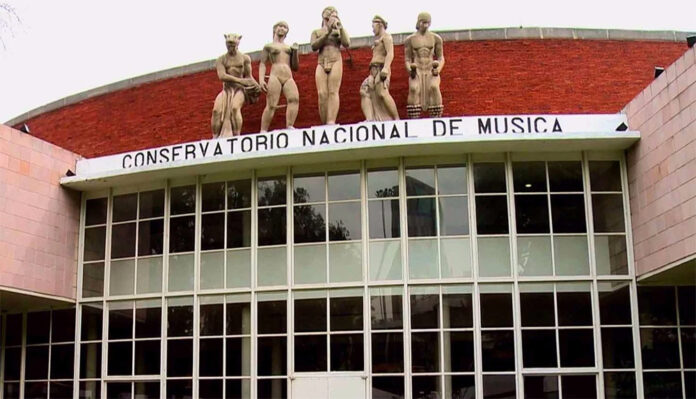by Mexico News Daily chief staff writer Peter Davies
President Claudia Sheinbaum on Monday presented an ambitious economic plan whose goals include making Mexico the 10th largest economy in the world, reducing reliance on imports from China and other Asian countries and creating 1.5 million new jobs.
Sheinbaum unveiled Plan México at the Museum of Anthropology in Mexico City, making her second major speech in two days after delivering an hourlong address on Sunday to highlight her government’s achievements during its first 100 days in office.
The president described Plan México as a long-term “vision for equitable and sustainable development” that promotes economic growth while prioritizing “wellbeing for our people.”
She said that the plan would “continue to promote” the relocation of foreign companies to North America as Mexico seeks to take advantage of what has been described as a “once-in-a-generation” nearshoring opportunity.
Sheinbaum said that there is already US $277 billion in the investment pipeline.
“We’ve reached the level of having counted $277 billion in [proposed] investment [from companies] that want to come to Mexico,” she said, adding that the planned outlay is spread across some 2,000 projects.
Sheinbaum also reiterated that the USMCA free trade pact, which is up for revision in 2026, has benefited each of its signatories — the United States, Mexico and Canada.
“It will be maintained because it has been shown to be one of the best trade agreements in history,” she said.
The president’s presentation of Plan México came exactly one week before the inauguration of United States President-elect Donald Trump, who has pledged to impose a 25 percent tariff on all Mexican exports and accused Mexico of being a tariff-free backdoor to the U.S. for Chinese goods.
The federal government has already begun taking steps to reduce reliance on imports from China, while seizing significant quantities of counterfeit Chinese goods and imposing new tariffs on Chinese clothing and products imported to Mexico via e-commerce sites such as Temu and Shein.
Its aim with the tariffs is to support and protect Mexican sectors that have lost competitiveness and consequently market share due to an increase in imports to Mexico, especially low-cost products from China.
Plan México could help appease Trump as it reinforces Mexico’s commitment to the economic region in which it is located: North America.
Economy Minister Marcelo Ebrard said late last year that Mexico would “mobilize all legitimate interests in favor of North America” amid the ongoing China-U.S. trade war that could intensify after Trump takes office on Jan. 20.
The goals of Plan México
Accompanied by cabinet ministers including Ebrard and Finance Minister Rogelio Ramírez de la O, Sheinbaum outlined 12 specific goals of Plan México to an audience that included various business sector representatives.
“As you can see, they are ambitious goals,” she told attendees as the 12 objectives were displayed on a screen.
“For example, going from being the 12th largest economy in the world to being the 10th largest economy. That’s the scale of our objective,” Sheinbaum said.
The full list of Plan México goals the president presented is as follows:
- To make Mexico the 10th largest economy in the world by the end of Sheinbaum’s term in 2030.
- To maintain public and private investment levels above 25 percent of Mexico’s GDP, and increase investment to above 28 percent of GDP by 2030.
- To create 1.5 million jobs in Mexico’s specialized manufacturing industry and other “strategic sectors.”
- To increase production in “strategic sectors” in Mexico so that they can supply 50 percent of the national demand for products made in those sectors. “That is the objective, at least, in the textiles, footwear, furniture and toy sectors as well as some others,” Sheinbaum said.
- To increase by 15 percent the use of domestically made contents in products made by the following sectors: automotive, aerospace, electronics, semiconductors, pharmaceuticals and chemicals.
- To have products made in Mexico account for 50 percent of all government purchases.
- To make (more) vaccines in Mexico.
- To reduce the average time between an investment announcement and the execution of a project from 2.6 years to 1 year.
- To train an additional 150,000 “professionals” and “technicians” per year, with a focus on preparing people to work in “strategic sectors.”
- To promote environmentally sustainable investment.
- To provide access to finance to at least 30 percent of small and medium-sized businesses. “We’re among the countries with the least funding for small and medium-sized companies,” Sheinbaum said.
- To make Mexico among the world’s top five tourism destinations. (Mexico is currently ranked seventh.)
Sheinbaum added that a “substantive goal” of Plan México is to “reduce poverty and inequality in our country.”
She explained that the aim of producing more in Mexico is to not just supply more products to the domestic market but also to “the regional market.”
“The United States also depends a lot on imports from China and [other] Asian countries. We’re going to strengthen the regional market. And, in addition, our objective is also to expand [trade and economic cooperation] to the entire American continent. That is the vision we want in order to be the region with the greatest potential and development in the world,” she said.
How will the federal government support Plan México?
Sheinbaum outlined a range of “actions” that will be undertaken in the coming months to support Plan México and help it achieve its goals. They are also detailed in a “first draft” Plan México document subtitled “National Strategy for Industrialization and Shared Prosperity.”
One measure is the provision of additional incentives to foreign and Mexican companies, which will be detailed in a “nearshoring decree” to be published this Friday.
Among the other “actions” are the following:
Mexico’s existing trade agreements, tariff policies (the government appears open to matching U.S. tariffs on certain Chinese imports) and “customs intelligence” will also support Plan México, according to the “first draft” document presented by Sheinbaum.
Sheinbaum said that the document was a “first draft” because additional “ideas” will be added to Plan México.
The president also said that her government has been developing a “public investment plan” that includes spending on highways, passenger rail projects, airports, industrial parks, energy (particularly renewable energy), water, housing, security, education and other initiatives.
‘The aim is for everyone to be part of the construction of Plan México’
In a speech at the Museum of Anthropology, before Sheinbaum presented the details of Plan México, Marcelo Ebrard said that various working groups, “all led by Doctor Claudia Sheinbaum,” developed Plan México.
He said the plan could be described as “a navigational chart for Mexico for the new era we’re going to face.”
The economy minister highlighted the speed with which the plan was developed and declared that it was “virtually dictated by the president.”
However, Ebrard also said that the plan was the result of “collective work.”
“The national private sector is [represented] here, as is the private sector of the [different] federal entities and the economic development ministers of the 32 federal entities,” he said.
“… So it’s a collective job. A navigational chart, as I said at the beginning. There is uncertainty in the immediate future, but if we are united and have a national direction, as we do, we will come out ahead,” Ebrard said.
In her address, Sheinbaum said there is “a plan, a project and goals” for each of Mexico’s 32 states within Plan México.
“And the aim is for everyone to be part of the construction of Plan México,” she said.
Finance minister highlights that import substitution will spur growth
Repeating remarks he made last year, Rogelio Ramírez said that the replacement of just 10 percent of Chinese imports with products made in North America would boost economic growth in Mexico, the United States and Canada.
He said that the replacement of one-tenth of Chinese imports with production in North America would add 1.2 percentage points to Mexico’s annual GDP growth rate, and 0.8 points and 0.2 points to growth rates in the United States and Canada, respectively.
Final 2024 figures aren’t yet in, but economic growth in Mexico slowed significantly in the first three quarters of last year compared to 2023, and is forecast to slow even more in 2025.
Ramírez highlighted that China has significantly increased its share of global trade this century, while the share of the USMCA signatories declined.
“This loss of participation cost us, especially Mexico and the United States, Canada less so,” Ramírez said, adding that a lot of factories in North America have shut down and a lot of jobs have been lost.
The effectiveness of Plan México in remedying that situation will become evident in the coming years.
By Mexico News Daily chief staff writer Peter Davies (peter.davies@mexiconewsdaily.com)












